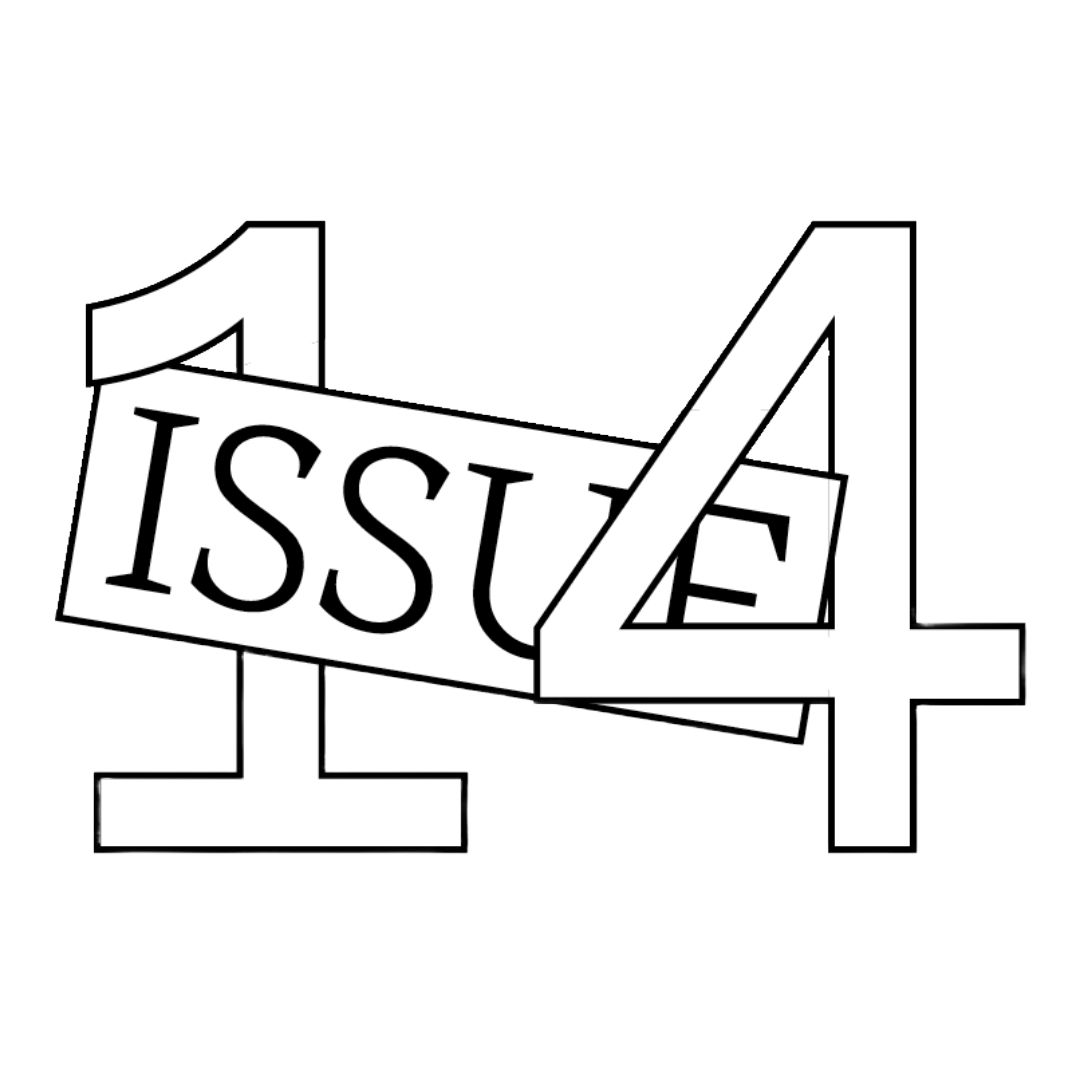Crisis of Trust
Leonardo Kaplan’s The Citric Fragment
Leonardo Kaplan, Them That Follow, 2023. Acrylic toner transfer, marker, dye, pen, pencil, and crayon on canvas. 32 x 26 inches.
Courtesy of the artist and Rivalry Projects. Photo: Ryan Arthurs.
In a collection of new works recently on view in his solo exhibition The Citric Fragment at Rivalry Projects, Chicago-based artist Leonardo Kaplan explores the dissonance of the contemporary American condition, and the national relationship to religion, through mediated images. Across his paintings, the artist portrays public figures alongside members of once-fringe sects whose beliefs have become increasingly normalized in the current context of the United States. For Kaplan, the mainstreaming of these ideals is made possible by a society whose undying allegiance to Christianity is defined by mega churches, religious theme parks, and opportunistic crime under the guise of faith.
Leonardo Kaplan, Apomixis, 2023. Acrylic toner transfer, marker, and dye on canvas. 46 x 21 3/4 inches.
Courtesy of the artist and Rivalry Projects. Photo: Ryan Arthurs.
The artist does not see himself in these subjects — fanatics, bigots, MMA fighters, and members of the military chief among them. Not only because these figures are foreign to the markers of his identity (a gay artist who was raised Jewish in Bogotá, Colombia, before immigrating to New England) but also because of the challenges these positions present to frameworks of empathy and understanding. Kaplan’s sincere but ultimately irresolvable engagement with biographically unrelatable source material underscores a larger inability to sympathize with the politics of panic and paranoia. In response to this lack of self-recognition, the artist turns to an aura of artificiality. Using a process of photographic transfer reminiscent of Dadaist collage with a Y2K palette, Kaplan realizes his subjects in a new light. At times, his paintings offer the visual equivalent of the assault rendered by the mania seeded by late-stage capitalism, the pervasive fear that penetrates public channels of communication, and crises of trust. At others, their status as paintings suspends the instinct simply to react. Kaplan’s paintings unfold slowly and carry the potential to speak in images what may seem inflammatory in words. Rejecting polarity — of the categorization between us and them, so comfortably reached in neoliberal models of media — the paintings insist on the tension of identification.
Leonardo Kaplan, Tears in Heaven (I, II, & III), 2023. Toner and tape on paper. 21 x 15 1/8 inches each.
Courtesy of the artist and Rivalry Projects. Photo: Ryan Arthurs.
In the triptych Tears in Heaven (I, II, III) (2023), the same image of famed televangelist Tammy Faye Bakker appears in various states of disintegration. No one painting presents a complete portrait. Kaplan fractures his source image, a still captured from one of the many times she cried on camera, into fragments of heavily made-up face, marked by bold false lashes and heavily lined lips. Tammy Faye’s was a marketed and televised sorrow meant to exonerate the guilt of a woman who accumulated her wealth by preaching the end times and defrauding her viewers. Despite this rough veneer, a sense of melancholy permeates the paintings. The resounding sadness in Kaplan’s work does not come from identifying with the performative action of the figures but is borne of a society that allows, and even encourages, these actions.
Emphasizing the bare hypocrisy of institutionalized religion in America, Kaplan’s translations are persistent in their approach. Made from pigments, toners, dyes, and photographic transfers layered between multiple coats of acrylic medium, the sleek polymer surface of each painting assumes the effects of collage while remaining entirely uniform and flat. In Emotional Chemical (2023), scrawls of highlighter and ballpoint pen crowd a backdrop of raw canvas from which the isolated elements of a face — disembodied eyes, the shadow of a nose, thin lips — stare out. Situated within a rectangular frame, as if clipped from the cover of a magazine, the features belong to Fred Phelps, the minister and disbarred lawyer famous for coining the phrase “God hates fags.” Them That Follow (2023) similarly features a figure, here a male teen whose expression recalls the spiritual ecstasy of Bernini’s sculpture of St. Teresa, against an atmospheric ground. A serpent encircles the boy’s collarbone, his hands clasped in prayer. While theatrical in appearance, the scene is not staged: the image was made in one of the last remaining churches of Appalachia to endorse the handling of venomous snakes. This worship is predicated on an interpretation of a passage in the Gospel of Mark in which Jesus identifies an ability to handle snakes as a mark of the true believer. As with the beliefs sermonized by many extremist Christian sects, the onus is on the individual, not the act — death is merely a consequence of a lack of faith.
Leonardo Kaplan, Emotional Chemical, 2023. Acrylic toner transfer, marker, pen, pencil, dye, and crayon on canvas. 44 x 28 inches.
Courtesy of the artist and Rivalry Projects. Photo: Ryan Arthurs.
While not always so sensationally expressed, a similar sentiment is far from the periphery of contemporary United States culture; on the contrary, it is alarmingly pervasive. The display of any patriotic gesture is enwrapped with religious connotations (“one nation under God”). Ideology and theology are intertwined as interconnected symptoms of manifest destiny, the idea that the existence of the United States is ordained by God, used to justify the expansion of democracy and capitalism across the North American continent through the dislocation and brutal mistreatment of Native American, Hispanic, and other non-European inhabitants of the territories it now occupies.
Here is where the remote hills of Appalachia and the city of Buffalo intersect. On May 14, 2022, a lone gunman entered a supermarket in the city’s East Side, murdered ten people, and wounded three others. The gunman, who was white, intentionally targeted the primarily Black neighborhood. The “great replacement” — a virulent white supremacist conspiracy theory that falsely claims that white Americans are being replaced through immigration, interracial marriage, and eventually by direct violence — motivated every elaborate detail of his manifesto. The letter was made accessible through Google Docs days prior and triggered no response. It is commonplace that a search of the names of most cities followed by “shooting” will yield similar results — this is a phenomenon unique to the United States. “But the [great replacement] conspiracy theory also animates another cornerstone of the modern Republican agenda: opposition to abortion,” wrote Jasmine Aguilera and Abigail Abrams for Time magazine, when the constitution right to abortion still hung in the balance. ¹Their article lays out the beginnings of the anti-abortion movement in the nineteenth century, as fears of a declining birth rate among the right kind of white people grew; in the 1870s, the Protestants lamented their numbers as compared to those of Jewish and Catholic immigrants from Italy and Ireland, now white power groups have reoriented these statistical games to demonize Black and Latino communities. ²For white women to have the right to an abortion would be a danger to their cause. While the Buffalo gunman did not explicitly mention the word “abortion” in his manifesto for domestic terrorism, he referenced the birth rates of white children more than forty times.
Leonardo Kaplan: The Citric Fragment, 2023, installation view, Rivalry Projects.
Photo: Ryan Arthurs.
Kaplan’s work responds to these issues in its opposition to assimilation — a violence that goes beyond any one instance within his paintings — and a general denouncement of dominance. Hematomatic (2023) pictures the mixed martial arts fighter, bare knuckle boxer, author, and model Paige VanZant’s post-match bloodied, cut-open face, which stands in stark contrast to her OnlyFans persona. In Kaplan’s rendering, the surfaces of her chin, neck, and shoulders not patterned with blood are treated with the artist’s phototransfer techniques in hues of acid green. Interrupted by the same style of illustration that adorns the other paintings, the work appears somehow more gruesome, more brutal, than the original photograph it replicates. The sadism inherent in the entertainment fighting industry connects to the religious undercurrent of Kaplan’s recent series, where the cruelty takes the form of the self-inflicted, repentant punishment of Catholicism. These expectations are met in many of the works on view in The Citric Fragment, challenged only by compositions such as Apomixis (2023), the most delicate painting in the exhibition (the title comes from a botanical term that refers to the asexual development of genetically identical plants, often invasively as in the growth pattern of dandelions). The painting features a man reclining on a field of fluid pigment dappled with dandelion flowers. His chest is bare, his jeans unbuttoned. His gaze is blocked; the black bar drawn in pen over the figure’s eyes is not the artist’s addition but found in the source image, clipped from a 1980s Italian pornographic magazine that required such paradoxical censorship for its classifieds. The black bar makes the idea of sight more complex: the viewer is implicated within an act of seeing a potential lover that depends on obfuscation because no other way is possible or safe.
Leonardo Kaplan: The Citric Fragment, 2023, installation view, Rivalry Projects.
Photo: Ryan Arthurs.
The differences in how gaze features in Apomixis and Emotional Chemical reveals the spectrum of Kaplan’s conceptual project. Between the guarded and the assertive, the characteristics of eyes within the artist’s paintings draw us into questioning acts of seeing. How, for example, do we look at those with whom we have nothing in common? How are we to reconcile the precise marriage, not separation, of church and state in the United States that purports belief as a supplantation of knowledge, or that devoutness excuses injury (in this life, because there is always the one after). That supposes where we find ourselves now is inevitable, just as God intended.
1 Jasmine Aguilera and Abigail Abrams, “What the Buffalo Shooting Has to Do With the Effort to Overturn Roe,” Time, May 14, 2022. https://time. com/6178135/buffalo-shooting-abortion-replacement-theory/
2 Jennifer L. Holland, Tiny You: A Western History of the Anti-Abortion Movement (Berkeley: University of California Press, 2020).
by Stephanie Cristello
Leonardo Kaplan, The Citric Fragment, was on view from September 1–October 20, 2023, at Rivalry Projects.
Stephanie Cristello (b. Toronto, ON) is a contemporary art curator and writer based in Chicago, IL. She graduated from the School of the Art Institute of Chicago in 2013 with a Liberal Arts Thesis in Visual Critical Studies. Cristello has worked internationally across a variety of platforms, including exhibitions, panels and symposia, editorial and publishing, and writing on practices of art and architecture. She served as the Artistic Director of EXPO CHICAGO (2013–2020) and is currently the Director / Curator at Chicago Manual Style, an experimental exhibition space, and Curator-at-Large at Kasmin (New York). From 2020–21 she was a Guest Curator at Kunsthal Aarhus (Denmark) and the Malmö Art Museum (Sweden), as well as a Curatorial Advisor to the 2020 Busan Biennale (South Korea).
She was previously the Senior Editor US for ArtSlant (2012–18) and the Editor-in-Chief of THE SEEN, Chicago’s International Journal of Contemporary & Modern Art (2013–20). Her writing has been published in ArtReview, BOMB Magazine, Elephant Magazine, Frieze, Mousse Magazine, OSMOS, and Portable Gray, among other outlets. Cristello has contributed to numerous exhibition catalogues, including monographs on the work of Lap-See Lam (Bonniers Konsthall / Lenz Press, 2021), Mamma Andersson and Tal R (Kunsten Museum / Malmö Art Museum, 2022), and Alma Allen (Museo Anahuacalli, 2023). She is the author of Theodora Allen: Saturnine (Motto / Kunsthal Aarhus, 2021), Sustainable Societies for the Future (Motto / Malmö Art Museum, 2021), and Barbara Kasten: Architecture and Film 2015–2020 (Skira, 2022). In 2020, she was awarded a publication grant by the Graham Foundation for Advanced Studies in the Fine Arts.







